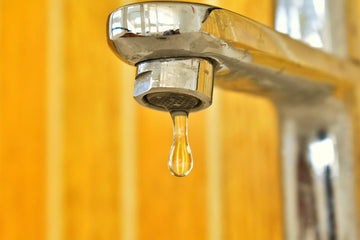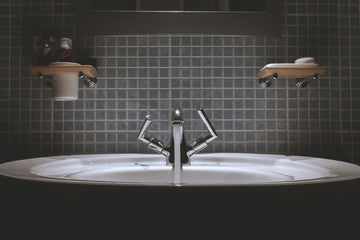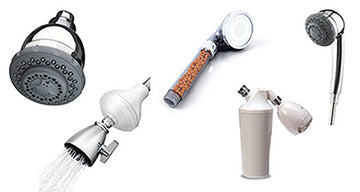Tips To Remove Calcium or Mineral Buildup from a Faucet
by LucasAlbert on Jun 16, 2021

We have previously shared articles about hard water and soft water, and those of you who have read or already know about hard water surely know that hard water contains more minerals such as calcium and magnesium, which evaporate when hard water passes through your faucet, and over time these minerals build up and become horrible deposits that attach to and around your faucet. Although these deposits are harmless, they look nasty and can make your faucet look dirty.
Removing calcium deposits is not so difficult, just follow the tips and steps below and use the right cleaning products and methods to get it done.
Before you start, you need to prepare these things to help you:
- Gloves
- Toothbrush
- Lemon juice or lemon wedge
- All-purpose cleaner (like dish detergent...)
- White distilled vinegar
- Rubber band
- Plastic bag
- Rags

Step 1: Perform Routine cleanings
Please wear your gloves before you start removing calcium deposits. Gloves will protect your skin from chemicals and irritants. (Remember to use gloves that cover all or most of your forearms, and make sure they are free of dirt.)
Next, get started. First, use an all-purpose cleaner or lemon juice to clean the entire faucet. Remember to use a mild detergent to avoid causing any damage to the faucet.
Then pour one to two tablespoons of detergent into a small bowl. Add two to three cups of warm water and mix these ingredients with the all-purpose cleaner to form some foam. Take a rag and soak it in the soap mixture. Use the soaked rag to scrub the faucet by gently circling the surface of the faucet. Thoroughly clean the handle, neck and base of the faucet.
Using a toothbrush soaked in baking soda to scrub the areas with dirt.
(You can make a baking soda paste by adding drops of water.) Use gentle back-and-forth motions, moving inward until the surface of the faucet is free of dirt.
For small cracks, cut a 12-inch piece of floss and place it between the spaces or cracks on the faucet's surface in an up-and-down motion to clean.
After completing the above cleaning, rinse the surface of the faucet with a damp cloth and cold water. Wipe the cloth over the surface to remove dirt, debris and the soap mixture from flossing, rinsing until the surface is clean.
Finally, run a microfiber cloth gently back and forth over the entire surface to dry the surface until completely dry.
Step 2: Dilute calcium remover in water
Take a bowl of water and mix it with one to two tablespoons of calcium remover. This ratio is the most effective. If the calcium buildup is not significant, you can use undiluted white vinegar to remove it.
This process takes time, but it is not recommended that you use vinegar or calcium remover on those faucets made of iron or nickel, as these removers can damage the finish of these faucets.
Step 3: Put the mixture into the plastic baggie and attach it to the faucet
Get a regular sized plastic bag and pour the mixture in. When holding it, make sure you hold it at a slight angle so that your mixture can pile up in one of the corners. Carefully slide the open end over the faucet, submerge the faucet in this mixture, and then securely fasten the bag to the faucet with a rubber band and let it soak for a few hours.
Step 4: Remove the calcium buildup
Undo the rubber band and take off the baggie carefully and slowly, and then dispose of it. After removing the bag, scrub gently with an old toothbrush in a back-and-forth motion to remove the buildup.
Keep scrubbing until it is completely removed. When finished, dry the faucet with microfiber, moving in a circular motion until completely dry.
Step 5: Remove the aerator
The aerator is a small filter with a screen on the edge of the faucet. Unscrew this part, brush off the calcium buildup inside with a toothbrush or other small brush, then put it in a bowl with vinegar for an hour, and finally dry it out and screw it back in.
Calcium minerals are formed from minerals left behind by hard water that evaporates from the faucet. These deposits gradually collect on the faucet over time and are not only unsightly, but have the potential to clog the faucet aerator. Follow our tips to keep your faucet clean and free from calcium deposits.



